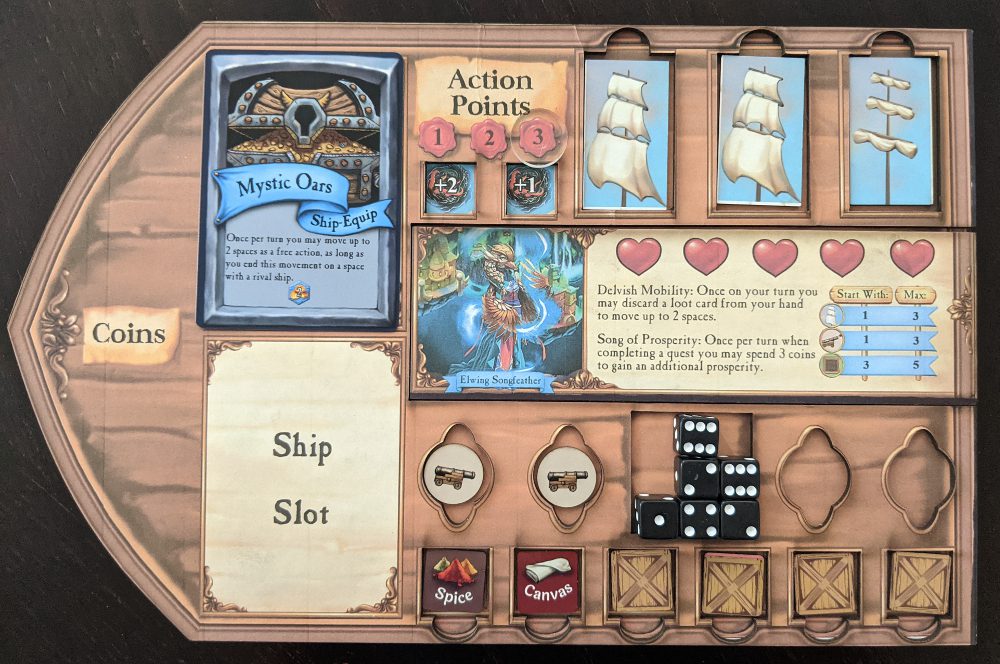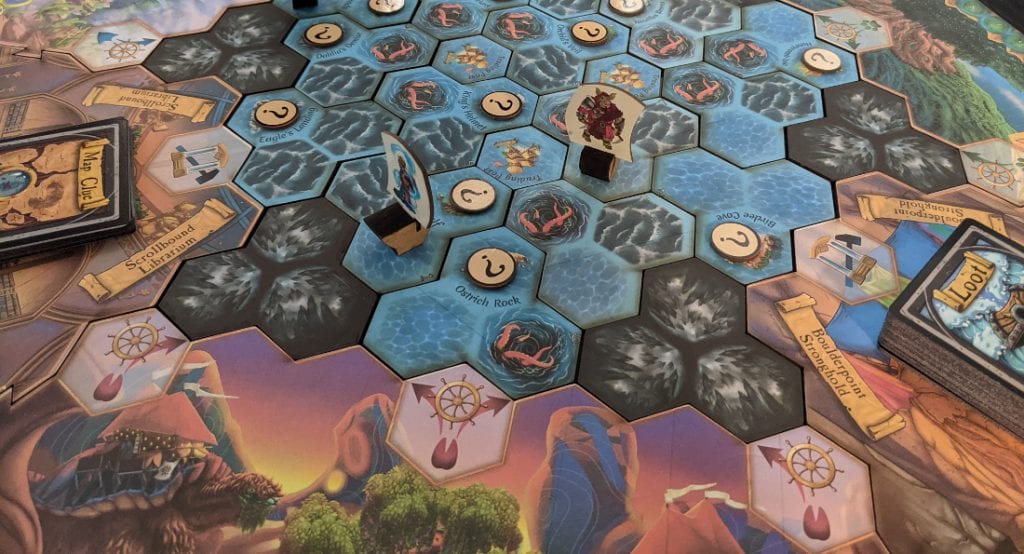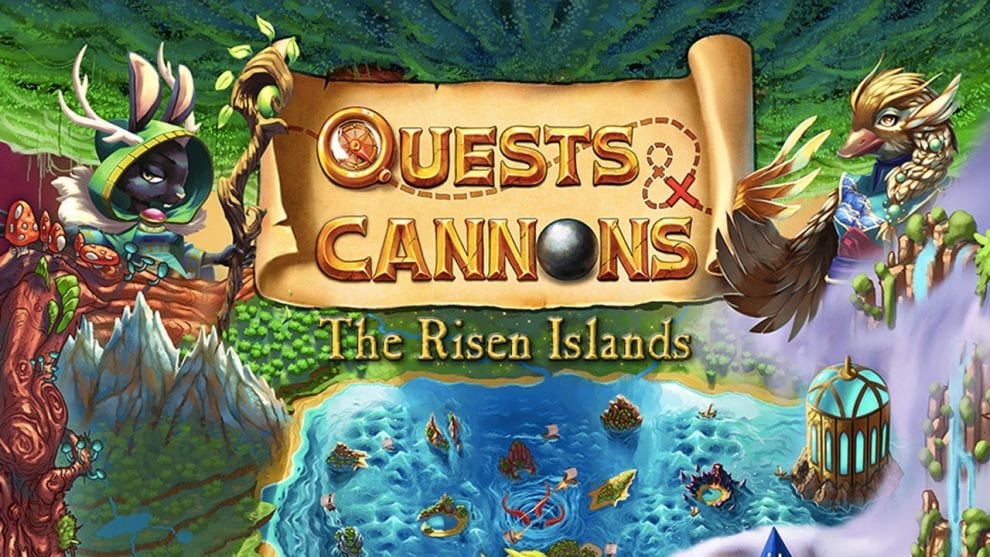Disclosure: Meeple Mountain received a free copy of this product in exchange for an honest, unbiased review. This review is not intended to be an endorsement.
Quests & Cannons: The Risen Islands (henceforth shortened to “Quests & Cannons”) is the debut title from Short Hop Games and first time designers Eric and Shannon Geller. It is a seafaring sandbox adventure with the visual elements of Redwall and Lord of the Rings ending their date with a passionate kiss. You are a captain of a useless ship, and it’s your job to explore these new “Risen Islands” to gather resources, complete objectives, and visit specific spots. Since this is a board game, the measurement of your progress is Victory… I mean Prosperity points.
As part of the game’s setup, you will pick a captain of your ship. Not only do they have stats for your cannons, sails, and cargo space, but also two special abilities. Nine captains represent the three nations of this animal universe. Besides the captains, you will also pick a mode for your game. You can play solo, teams, or free for all. A variety of pre-made maps for every mode is available, or you can randomize them. My suggestion? Do it pre-made. One player whose moves are easier to make than others will have a noticeable advantage in this game.
Get Used To Three
Speaking of turns, you start with three action points, and you can do three different actions. The first one is moving around, which is vital because you can’t explore the islands or shoot other players without leaving your starting area. After moving one space, you may exhaust your Sails to move additional spaces. There are various space types, such as stormy seas and trading posts, but we’ll get to that later.
The second way you can act is by firing your cannons. You always start with five six-sided dice representing your ammo. When you share the same space as your opponent, you can fire at them by flipping your cannons to their used side. For each cannon used you roll a die, and for every four pips you deal a point of damage to your opponent. You get one point if you successfully inflict damage on your opponent and you earn another three points by sinking your opponent’s ship. Don’t worry, a sunk ship simply means they begin their turn on the starting space. No player elimination here.
Finally, you can do a Gather action. Every island produces one specific resource. When you gather, you grab as many resources as you can, provided you have the cargo room to carry them. You can spend these resources to upgrade your ship, complete quests, or sell them outright.

Explore and Exploit
At the start of the game, these islands will have their resource tokens face down. If you end your movement action on these islands, and you are the first one there, you flip the resource token face-up and earn one gold coin. By simply landing on an island, explored or not, you draw a quest card. These quest cards are one way to earn some loot, prosperity points, and gold.
As someone experienced in sandbox games, I find the questing system appealing. There is something particularly frustrating about the random quest draws and lack of player agency in this genre. You’ll often end up with the quests you receive that are annoyingly hard to achieve, while your opponents might have a far easier time, giving that sense of unfairness because of the game’s systems.
Due to frequent visits to these islands, a high influx of quest cards isn’t out of the norm. You have a hand limit of three quest cards at the end of your turn. Despite that restriction, this allows you to filter through your quests. You decide which routes to take, what resources to grab, and so forth to score those sweet Prosperity Points. It’s like a power fantasy for the unemployed where you choose your work.
There is one other reason to visit these islands outside of quests and resources. At the start of the game, you will have one Map Clue card. This card will name a specific island that you need to visit. After landing on that island, you can reveal your Map Clue card by spending an Action Point. You now have the option of either gaining one Prosperity Point or receiving one Loot card and then drawing another Map Clue card. With these face-up Clue cards, you can return to your starting space and cash them in for extra points. A big catch is that if your ship sinks, you lose all of your face-up Clue cards, so you need to push your luck, along with some good route planning.
Donning the Captain’s Hat
I guess we ought to take a moment to explain the different spaces, now that we are discussing route planning. In the middle of the board lie three Trading Posts, which allow you to trade or sell resources and buy Loot or Clue cards. In the three corners of the map, you also have Outposts where you can finish quests, sell goods, and upgrade your ship.
The last two sea space types are the Stormy seas and Treacherous seas. Much like the ocean in real life, moving your ship isn’t exactly a consistent experience. The Stormy spaces require you to spend two movement points to enter, and the Treacherous spaces force you to roll a die. You have a 50% chance of succeeding, and if you are successful, you move one space for free. Failure means the red tentacle gives you a goodbye hug, therefore one point of damage, forcing you to spend your next Action Point to move out of there. While this might not sound like a big deal, you will learn quickly about the importance of your limited Action Points and Sails. You will intentionally make stupid decisions like steering into the tentacles to avoid using an additional Action Point or Sail on your next turn.
To help you on your way and aid you with your quests, you will get some Loot cards. You can purchase Map Clues and Quest cards at Trading Posts or earn by completing certain quests. The Loot Cards come in two flavors: Blue or Red. Blue cards are permanent abilities that go into your two Ship slots, thus giving you more tools to play with outside of your Captain’s abilities. The Red cards are one-time use and tell you when you can use them. Nothing too out of the ordinary with card play in these types of games.

It’s Not You, It’s Me
Having said all the above, I will admit that games like Quests & Cannons are not my cup of tea. Despite this admission of subjectivity, I appreciated the design and enjoyed it more than other games of this genre.
When I say other games, I mean the big boys and girls here. Xia: Legends of the Drift System? Kickstarted it and sold it. Merchants and Marauders? Great game that takes far too long to finish. Wasteland Express Delivery Service? It has nice inserts, I guess.
Those three games are like being served a good cocktail. You have the alcohol, of course, but they also distract you with its sprinkled rims and visual aesthetics for good measure. Quests & Cannons is a straight vodka shot, and as a half-Polack, I have to respect the game being brutally honest for what it is. It doesn’t shower you with a confetti of complications to hide its true nature.
For the sake of transparency, the only reason I got this copy for this review is the designer read my Terror Tokens review. He liked my honest, upfront opinions and wanted the same treatment for his design.
Unfavorable Weather Conditions
Starting off with the areas I didn’t enjoy is a great way to go. For instance, upgrading your ships is not my favorite. In sandbox games like this, design wisdom usually suggests players to upgrade their vessels or characters by spending money. Xia: Legends of the Drift, for example, lets you improve your ship’s weapons, shields and buy new ships using credits. There is a certain excitement in this situation since you can decide how to earn credits, whether by mining, missions, or bounty hunting. This isn’t how Quests & Cannons works.
Instead, you need specific resources to upgrade your ship. Want more sails? Canvas and three gold. More cargo storage? Lumber and three gold. Every resource and three gold ties into something.
With that in mind, this means the captain you pick with their ship stats might not be efficient due to the random resource distribution. Every resource token starts face down, and it’s only by your discoveries that you learn more about the map. If you can’t get your plans to work with the current map setup, you’ll likely learn the hard way after investing a fair amount of turns into the game. That lumber you needed? It’s on the other side of the map behind some nasty weather and tentacles. Much like the American economy, there are no safety nets here.
If I were to put on my designer hat here for a second, I would have added the option to spend six gold to get whatever upgrade you need. Thus, you have the choice between being economical with your gold through the use of the right resources or paying a hefty premium to skip the resource requirement. Six gold cost is not the magic number here, but it gives you some agency if the randomization does not work out for you. The trading posts allow you to trade two resources for one, but on some ship setups, this might not be the viable alternative and will make you walk the plank towards an ocean full of unproductive turns.

Wet Gunpowder
Another area of concern is combat. It’s not the dice rolling that I have a problem with. If anything, I think the ‘every four pips is a hit’ is a brilliant system. It’s the defense against an attack that’s the problem.
Much like any other game with cards, the Loot cards allow you to bend the rules. They can do things like make water traversal easier or provide an extra cannon. Additionally, there are others that help you defend against attacks. In Quest & Cannons’ case, defense means outright denial. The player cannot attack you when you play a defensive Loot card. Might as well be a card with the word “Nope” on it in Comic Sans font.
Honestly, I’m surprised at this. There are many variables and systems at play here, inviting far more creative means to defend yourself. My mind can imagine several options, such as increasing the number of pips needed to make a hit, reducing damage, limiting the number of attacks, or forcing the attacker to discard extra ammunition. Because of the current state of the game, an aggressive player simply beelines for the player with the fewest amount of Loot cards. It’s not the most interesting choice.
She’s Still A Good Ship
Now that I aired my issues like dirty laundry, let’s talk about what I like. After playing Quests & Cannons quite a few times, it’s clear that there was plenty of playtesting done, and the designer has a fetish for the number three. One of my biggest problems with the sandbox genre is this attempt to slap all these gameplay styles together using the cheapest glue possible. In this game, everything ties together as if a master Loomer was working overtime.
A crucial strength of this game is its ecosystem. You and your friends will actively influence the type of experience you will get from your play sessions through collective decisions. If you want to play an 18-wheeler of the sea, slicing through the waters to finish quests, the game will adapt and give you that route efficiency experience. If a player or two tries to win the game with iron violence, suddenly it becomes a dice chucker, while the traders have to plan like gazelles running away from the hungry crocodiles prowling the waters. It does all of this maneuvering without skipping a beat, having as much flexibility as a book on Kama Sutra.
Even though I outright admitted that this genre isn’t for me, this was a pleasant surprise despite some of my issues. It’s streamlined with most of the fat cut off while still maintaining the integrity of the genre. Folks who want more of a pure, straightforward sandbox experience should give this one a look.











Add Comment